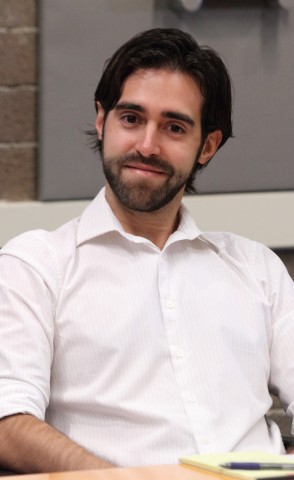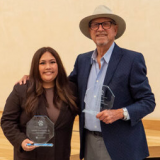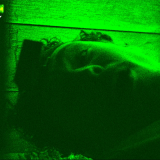Interview with Kyle Klütz: Inspiration, film theory, and teamwork in practicing cinematography
October 24, 2013
I recently got some time to tap into the mind of
the newly-crowned Emerging Cinematographer of the Year
, alumnus Kyle Klütz, to see what advice he could share with current Dodge College students, straight from the professional world. We cover everything from collaborating with a director, to applying film theory on-set, to which classes prospective cinematogs should take.
And, of course, the notoriously impossible-to-answer “favorite film of the century” question. Students of the camera, listen up!

Jared Parmenter: When did you make the decision to pursue cinematography, as opposed to another aspect of filmmaking?
Kyle Klütz: I’ve always gravitated towards cameras, but it was probably working on my first student film at Chapman that brought the role of the cinematographer to my attention. It’s the perfect blend of art and craft. I couldn’t learn enough about lighting and exposure whether it was in a classroom, workshop, or textbook. There was (and is) an inherent magic in creating images for film that I wanted to learn.
How does formal film theory affect your practical camerawork? What do you bring from the classroom, to the set?
I think “formal” film theory and the established techniques and “rules” are essential to know and understand. It’s all the foundation of our cinematic language. You can’t begin to express yourself without knowing the basics. Composition, lighting, color, camera movement are all fundamentals of visually storytelling. At first we’re searching for their examples or definitions. Later, once we’ve started employing what we learned via practical experience, we start to add our own taste into the mix and that is where your technique really starts to develop.
Do you ever find yourself re-creating or being inspired by scenes or camera movements from classic films? If so, what sticks with you?
It’s hard not to get inspired with so many talented filmmakers and artists out there. I have too many references to list, but I’ll try and give a few examples. Most recently, Steve McQueen and Sean Bobbitt’s collaboration on 12 Years a Slave and the way they hold on moments and characters that truly amplify the emotion and tone. Alfonso Cuarón and Emmanuel Lubezki’s work on Gravity has elevated visual effects, 3D, and camera movement to a level that four years ago would be impossible to attain. Spielberg and Zemeckis are unparalleled in their camera blocking. I still can’t believe what Christopher Nolan and Wally Pfister were able to pull off together; both in the Dark Knight Trilogy and Inception. I still get chills thinking about the mid-air hijacking in Dark Knight Rises, the rotating hallway in Inception and the 18 wheeler jackknifing on La Salle St in The Dark Knight.
If we’re talking “classic films” in the sense of Golden Age and earlier, then I think all of the previous examples are derivations from the early masters.
What’s your process when collaborating with a director? Do you like to be hands-on, and let a shoot flow, or come at it from a more structured idea beforehand?
The more prep time I have with a director, the better. The more time I can spend talking with the director about their vision for a project, the better chance I have of translating it to the screen. It’s important to come up with a foundation for the structure and style of a film before stepping foot on set. That being said, the more I feel I I’ve prepared, the more comfortable I feel when new ideas come along in the “flow” of things since a “mantra” has already been established.
Will you be working with the same team in the future? What’s your next project?
I’m always happy to work with Clark Baker, the director, again. I know he’s busy in development on a couple of projects right now. It’s so great to see this project, which he was so passionate about, pay off like this for him. As for my crew, I hope to work with them whenever they’re available. I would not have been able to achieve such wonderful results without them.
Next, we’re waiting to hear from Sundance if our feature “Honeymoon” was accepted. Other than that, I’ve finished another short with Chapman Alum Carles Torrens and am looking forward to our next feature collaboration, hopefully next year.
Which Dodge College classes or professors would you recommend for other Emerging Cinematographer hopefuls?
Jurg Walther and Mark Parry were always there for me both in and out of the classroom. Both were so encouraging and always had constructive criticism to offer on my work. Any time I had questions about shooting a new project, and I had plenty, they were there with guidance. I was lucky enough to catch Bill Dill, ASC’s first class at Chapman; “Art and Craft of Cinematography.” His passion on the disciplines of cinematography was so inspiring. Those three professors were instrumental in helping me along the way.
If you could pick just one, what’s your favorite film from the past year? The past 10 years? The past 100?
This is a notoriously impossible question for any film major. [But so much fun to ask, for an interviewer! –JP] The Impossible may have been my favorite film of last year. In the past 10-100, Amelie is number one with The Dark Knight a close second.
Any advice for other film students in general, and cinematography students in specific?
Make as many movies as you can. Work with as many other students as possible and build a network where you can share your ideas and beliefs. Make mistakes, learn from them, and ask others what mistakes they’ve made and what they’ve learned. Don’t be afraid to fail, you may be pleasantly surprised with the results. Or, fail while you’re still in a relatively consequence free environment.
Great advice for students of all stripes, really.
Kyle is currently hard at work on his next project – in fact, a few of them! You can find more information about Kyle, and examples of his work,
on his website
and on
his Vimeo profile
.

